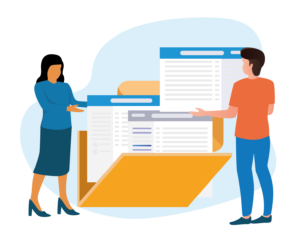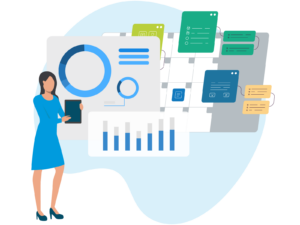7 benefits of property lease management software
Lease management software has become a valuable tool for businesses who need to streamline their lease management processes. From small enterprises to large corporations, implementing lease management software delivers numerous benefits and advantages. What can a lease management solution do for your business? In this article, you’ll learn seven key benefits of using lease management software.
1. Automated workflow
Lease management software plays a vital role in streamlining and automating lease management workflows. The software uses advanced technologies to significantly simplify and enhance the efficiency of lease-related tasks.
One key benefit of lease management software is automating lease tracking and documentation processes. The software eliminates the need for manual record keeping and paperwork, letting businesses store and access lease agreements, amendments, and other crucial documents in a centralized digital repository. This automation ensures easy retrieval and reduces the risk of misplaced or lost documents.
Lease management software also automates critical dates and reminders, such as lease expirations, rent escalations, and renewal options. It sends automated notifications and alerts to relevant stakeholders, minimizing the chances of missing important deadlines and ensuring timely actions.
Additionally, the software streamlines financial processes by automating rent invoicing, payment tracking, and expense reconciliation. It integrates with accounting systems, eliminating the need for manual data entry, and reducing errors.
2. More actionable insights
Lease management software helps businesses gain actionable insights through robust analytics and reporting capabilities. By extracting valuable information from lease data, the software facilitates data-driven decision making and enables stronger lease management strategies.
Comprehensive lease data analysis is made possible with lease management software. It generates reports and visualizations that deliver an overview of lease portfolios. These reports highlight key metrics like lease expirations, occupancy rates, rental income, and lease terms. Analyzing this data helps businesses identify trends, patterns, and potential risks, enabling informed decisions about lease negotiations, renewals, and portfolio optimization.
Forecasting capabilities enable businesses to project future lease-related outcomes based on historical data and market trends. Timely forecasting enables proactive planning so organizations can anticipate lease expirations, rent escalations, and financial obligations to mitigate potential risks.
3. Reduced lease standard compliance risk
Lease management software ensures lease standard compliance by incorporating specific features and functionalities aligned with accounting standards like ASC 842 and IFRS 16. A lease management solution facilitates accurate lease classification, helping businesses determine whether to classify a lease as an operating lease or a finance lease based on defined criteria.
The software supports lease accounting and reporting by automating calculations for lease-related expenses, such as lease liabilities, right-of-use assets, and interest expenses, in accordance with the lease standards. Lease management software generates standardized financial reports, ensuring compliance with prescribed accounting guidelines.
Additionally, lease management software includes lease auditing capabilities so businesses can perform internal audits and validations of lease data. The audits ensure the accuracy and completeness of lease information, identifying non-compliant leases or discrepancies that require corrective actions.
4. Easier document sharing
Lease management software greatly facilitates document sharing within an organization and beyond. With its robust features, this software simplifies document collaboration and improves overall communication efficiency.
Lease management software provides a centralized repository for storing and organizing lease-related documents. This centralized database ensures all relevant stakeholders have access to the latest versions of leases, amendments, addendums, and other critical documents. This centralization eliminates the need for multiple document copies and reduces the risk of outdated or conflicting information.
This type of software also offers secure document sharing capabilities. Users can grant specific permissions and access levels to different individuals or teams, ensuring only authorized personnel can view or modify sensitive documents. These permissions enhance data security and confidentiality.
5. Centralized database
Lease management software is crucial for developing a centralized database of lease-related information, offering numerous benefits to businesses.
First and foremost, lease management software consolidates all lease data into a single, centralized repository. Instead of scattered files and physical documents, the software provides a digital platform where lease agreements, amendments, correspondence, financial records, and other relevant documents can be stored and organized in a structured manner. This centralization ensures easy access to all lease-related information, eliminating the need to search through multiple locations or rely on disparate systems.
Lease management software also provides efficient data entry and data import capabilities. Users can input lease information directly into the system or import data from external sources, such as spreadsheets or existing databases. This accessibility streamlines the process of populating the central database with accurate and consistent lease data.
Lease management software often offers robust search and filtering functionalities, making it easy to retrieve specific information from the centralized database. Users can search for leases based on criteria like tenant names, lease terms, key dates, or property locations, saving time and improving data retrieval efficiency.
6. Simpler user interface
Lease management software is designed with user-friendly interfaces that simplify the lease management process and enhance usability for businesses.
One way lease management software achieves a simpler user interface is through intuitive navigation. The software typically organizes lease-related functions and features in a logical and user-friendly manner. Users can easily locate and access the necessary tools and information, reducing the learning curve and improving overall user experience.
Lease management software often incorporates customizable dashboards. These dashboards provide a personalized view of lease data, key metrics, and important tasks. Users can configure the dashboard to display the specific information they need, enabling quick and easy access to relevant insights.
The software also typically offers user-friendly forms and templates for data entry and document creation. These forms guide users through the necessary fields and ensure consistent data input. With pre-defined templates, users can quickly generate lease agreements, amendments, and other documents, saving time and reducing errors.
Moreover, lease management software often includes contextual assistance and tooltips to help users understand features and functionalities. This proactive support system enhances user comprehension and encourages self-sufficiency when navigating the software.
7. Increased time saving
Lease management software significantly contributes to time saving through automation and streamlined processes.
Centralized document storage and retrieval functionality eliminates manual paperwork and searching through physical files. The software provides a digital repository for quick and easy access to lease agreements and important documents.
Automated critical date tracking and reminders ensure teams do not miss important deadlines. The software sends notifications for lease expirations and rent escalations, saving time spent on manual tracking.
Lease management software automates financial processes like rent invoicing, payment tracking, and expense reconciliation. Integration with accounting systems reduces errors and eliminates manual data entry, speeding up financial workflows.
Reporting and analytics capabilities provide instant access to lease-related insights and metrics. These capabilities eliminate manual data compilation and analysis, saving time in generating reports and making informed decisions.
Lease Management Software
Lease management software for complete and easy control over complex lease portfolios.
Get a demo
Reduce the risk and complexity of lease management
By understanding the benefits above, businesses can make informed decisions about adopting lease management software, unlocking its potential to optimize lease management operations and drive organizational success.
MRI Software develops lease management software that maximizes the efficiency of the leasing process. From organizing lease administration to simplifying the implementation of lease modifications, our solutions are robust, capable, and hugely beneficial to commercial real estate occupiers. Contact us today to learn how lease management software can help your organization.
[On-Demand Webinar] AI Powered Lease Administration for Industrial Firms
Join Thomas Educato and Nicholas Leck, as they outline how AI can structure data, provide use cases, and then describe how human AI collaboration can support people in their roles.

